Telluride is Expensive. A New Housing Initiative Seeks to At Least Make Living Nearby More Affordable
Leer en español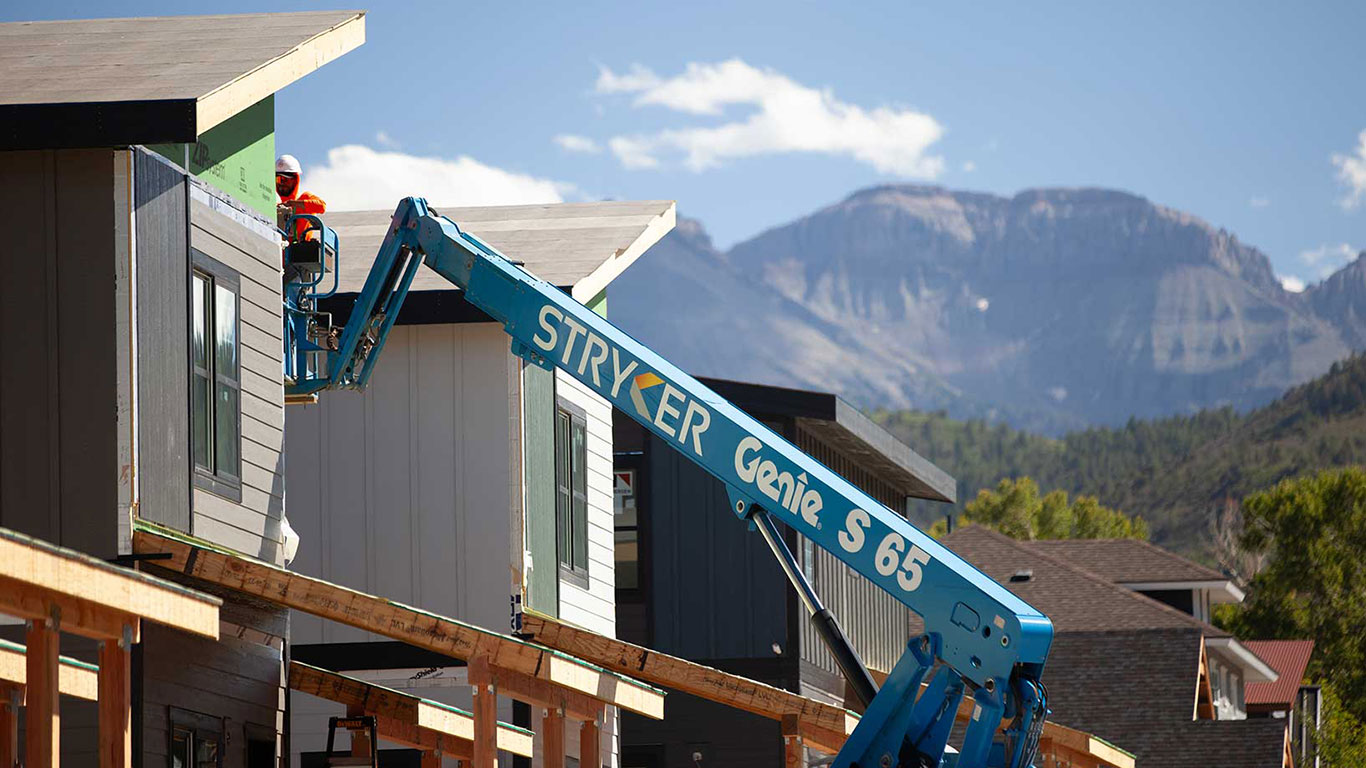
A worker installs siding on a new house at the Rural Homes development in Ridgway, Colo. Photo by Corey Robinson / Special to The Colorado Trust
By Mark Stevens
For the tiny Norwood School District, the deal was too good to pass up.
When 24 new houses started taking shape a few blocks south of downtown Norwood—located in southwest Colorado, with a population of less than 600—in a development called Pinion Park, the district decided to buy one of the homes.
Purchasing the house “took a significant bite out of our reserves,” says Norwood School District Superintendent Todd Bittner, “but it was an essential piece for us to be able to pull in staff.”
That new staff member fills a needed gap. The school district, which serves 193 students from kindergarten through 12th grade, has not had a science instructor since the 2020-21 school year.
The school district paid $285,000 for the two-bedroom, two-bathroom house. In turn, the district collects rent from the teacher and her husband, who works as an executive chef in Telluride.
Without the Pinion Park option, says Bittner, “I’m not sure what we could have done, to be honest, without it. To be able to afford a house that’s around $300,000 in a bedroom community to Telluride? It isn’t going to happen.”
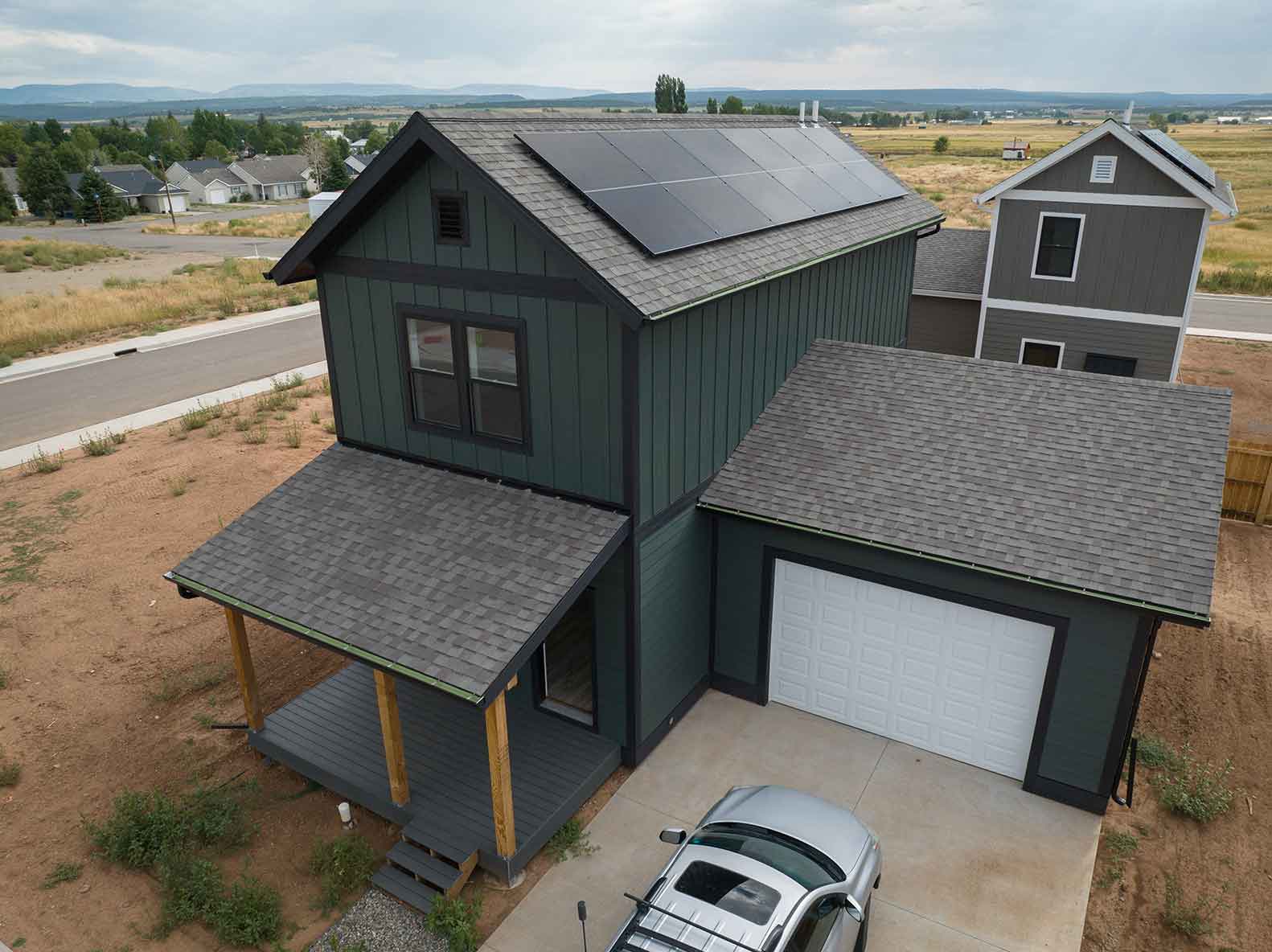
A recently completed house in Rural Homes’ Pinion Park development in Norwood, Colo. Photo by Corey Robinson / Special to The Colorado Trust
The Pinion Project in Norwood, along with similar developments in Ridgway and Ouray, is the work of a nonprofit company called Rural Homes. (The Colorado Trust has provided funding to Rural Homes.)
Norwood sits atop Wright’s Mesa at an elevation of 7,000 feet. For the past 146 years, the town has served as a hub for farmers and ranchers. For thousands of years before that, Ute Indians lived on the mesa.
The ultra-expensive Telluride is 33 miles away, but the scramble for housing has placed pressure on all communities within commuting distance. In Telluride, according to Realtor.com, the median house listing is $4.5 million. In Norwood, it’s $652,000.
“Telluride is a wealthy, privileged community with enormous resources,” says Rural Homes President & CEO Paul Major. (He also led the Telluride Foundation from its inception in 2000 until 2022.) “We’re trying to solve for places that don’t have the resources to attract the science teacher, retain a deputy sheriff, attract a nurse—all of these professions that are local and there’s no answer for them.”
Private developers, says Major, “are building to the top of the market… they are not building for teachers.”
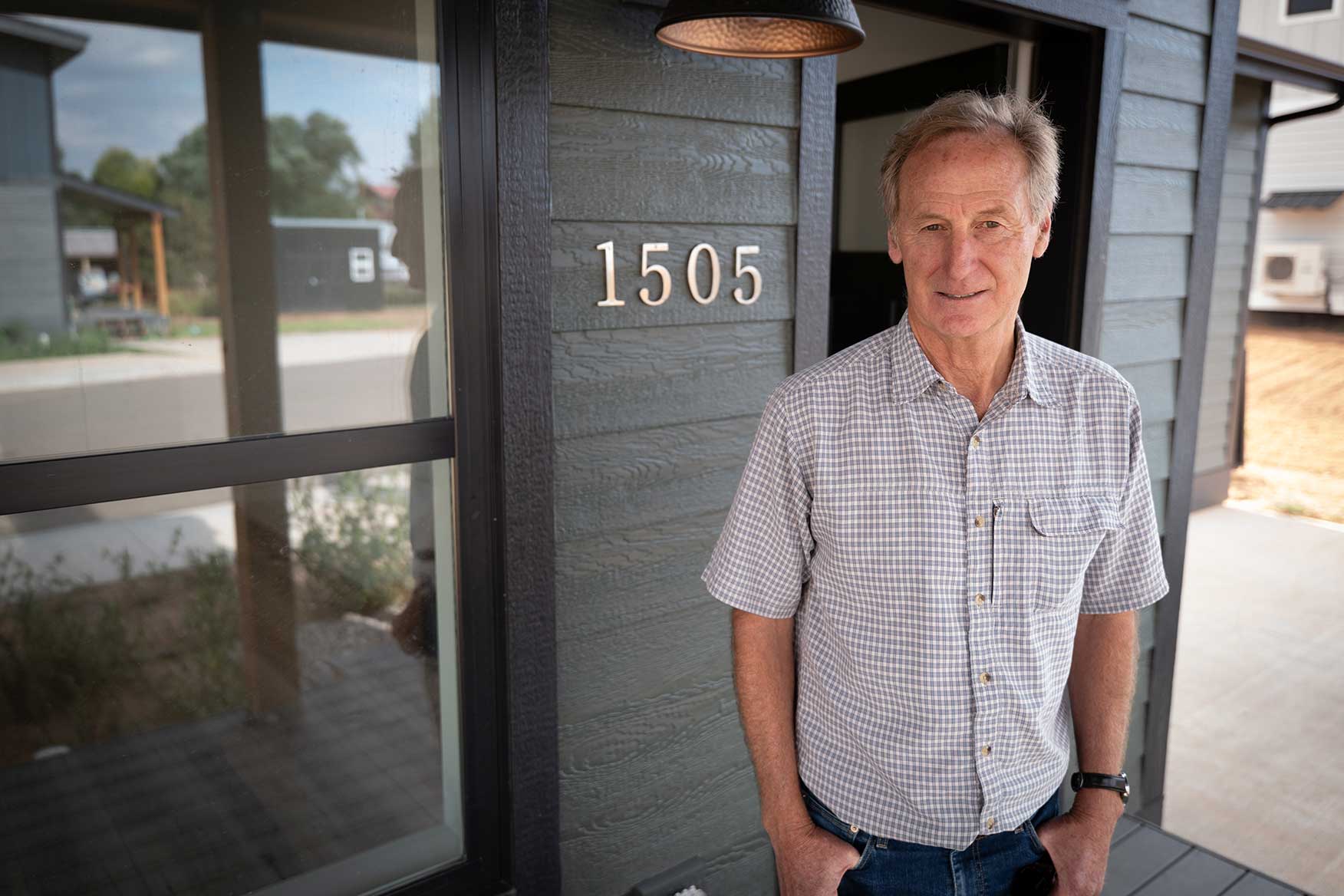
Paul Major, president & CEO of Rural Homes, outside one of the company’s new homes in Norwood. Photo by Corey Robinson / Special to The Colorado Trust
Rural Homes’ work in Norwood, Ouray and Ridgway is designed to help the workforce in each of those three communities. But the housing pressure in those towns would likely not be the same if they were not located fairly close to the quaint mountain town of Telluride. Finding affordable housing in Telluride is about as rare as finding yourself skiing alone on a powder day down the Boomerang ski trail high above town. Cases in point:
- Of the 30 employees at the Wilkinson Public Library in downtown Telluride, only four live in town, according to Joanna Spindler, the library’s adult services manager.
- Telluride Ski & Golf owns and manages a wide variety of apartment buildings and condominiums that are heavily discounted for resort employees. But the company is only able to assist with living accommodations for roughly two-thirds of the 1,800 or so workers it needs during peak winter season, according to John Young, resort services manager for Telluride Ski & Golf.
- The Colorado Department of Transportation no longer bases employees at its Deep Creek facility along the San Miguel River, says John Lorme, assistant maintenance superintendent for CDOT’s Region 5. Because nearby housing is so expensive, the routes into Telluride are serviced by crews based in other cities and towns. CDOT plans to build employee housing on the facility site, about seven miles from downtown Telluride.
- Of the five employees in the finance department for the town of Mountain Village, the resort community adjacent to Telluride with many high-end homes, not one lives close to work, according to Assistant Town Manager Michelle Haynes. One employee drives 55 miles one-way from Nucla; another drives 65 miles one-way from Montrose.
“I really applaud Rural Homes for breaking new ground and creating new models,” Haynes says. “You have to try, and [Paul Major] is doing the heavy lift.”
Like its counterpart developments in Ridgway and Ouray, Pinion Park in Norwood is being built as a pilot, to learn if the concept will work. Rural Homes’ cost-savings approach starts with purchasing houses from Fading West, a Buena Vista-based company that builds modular units. Final assembly at sites like Pinion Park involves stitching together the first and second stories of the structures, hooking up the plumbing and electrical systems to the town infrastructure, assembling the roof, and other finishing steps.
Once the homes are completed, the word “modular” would never occur to the average passerby. They look every bit as if they were built on the spot. The houses are energy-efficient with rooftop solar panels and air-source heat pumps. Some come with detached sheds for storage. All come with energy-efficient appliances and are wired for broadband internet.
Applications to buy in Norwood are handled by the San Miguel Regional Housing Authority; in Ridgway and Ouray, applications are managed by Impact Development Fund. Applicants must meet strict criteria that are managed by deed restrictions: Is the household income below 120% of the area median income (AMI) of $95,760 in Norwood, or $89,400 in Ridgway and Ouray? Are net assets below $900,000? Does the potential buyer, or anyone in your household, own improved residential property within a 150-mile radius?

Yasmir Torrez works on installing decking at the Rural Homes development in Ridgway. Photo by Corey Robinson / Special to The Colorado Trust
Potential buyers must be active participants in the local workforce. The house must be the buyer’s primary home and appreciation on the properties is limited to 3% annual growth.
The houses “are for people that work in the community who can’t afford a house now,” says Major. At Pinion Park, he says, the first wave of buyers has been at 80% of the AMI benchmark.
In Norwood, San Miguel County donated the land for Pinion Park. In Ridgway, Rural Homes’ Wetterhorn housing project benefitted when an anonymous donor bought the land and donated it to the cause. In Ouray, the land purchase cost was held down by a low-interest loan from the Colorado Division of Housing that utilized federal American Rescue Plan Act dollars.
The Rural Homes initiative also benefited from grants. The Colorado Division of Housing provided a grant worth $40,000 for each house. The Colorado Trust, Colorado Health Foundation, Caring for Colorado Foundation, Saul Zaentz Foundation and other funders and individual donors have helped with general operating expenses and buyer gap-assistance for qualified homeowners.
Yet issues continue to challenge Major and his three staff members. Some are related to construction. Others are a factor of the current market, including high interest rates.
Assembling the Pinion Park houses in Norwood during a heavy, windy winter caused problems with siding and roofing. Interior drywall texture cracked in the shipping process and needed redoing.
In Ridgway, city officials ordered that the new roads for Wetterhorn meet a standard known as “zero deflection,” meaning that the road must show no give from heavy trucks—a surprise $75,000 expense. Redoing a nearby culvert for drainage will cost another $30,000, even after the project’s plans were approved by the town. And in Ouray, Major has spent hours at public meetings to try and calm homeowners who complain that the new construction will mar their pristine view up the valley.
In the months between groundbreaking at Pinion Park in Norwood and starting to assemble the 14 houses in Ridgway, construction costs rose 20%. Rural Homes’ work faces another 10% hike in Ouray, says Major. A new law signed by Colorado Gov. Jared Polis tightened construction standards in order to increase wildfire resistance, adding to Rural Homes’ costs in all three developments.
And in Norwood, not all the houses have sold, creating carrying costs for Rural Homes. In late September, eight houses remained vacant, ranging in price from $354,500 to $410,000. Major says four applicants are working their way through the deed restriction and loan application process.
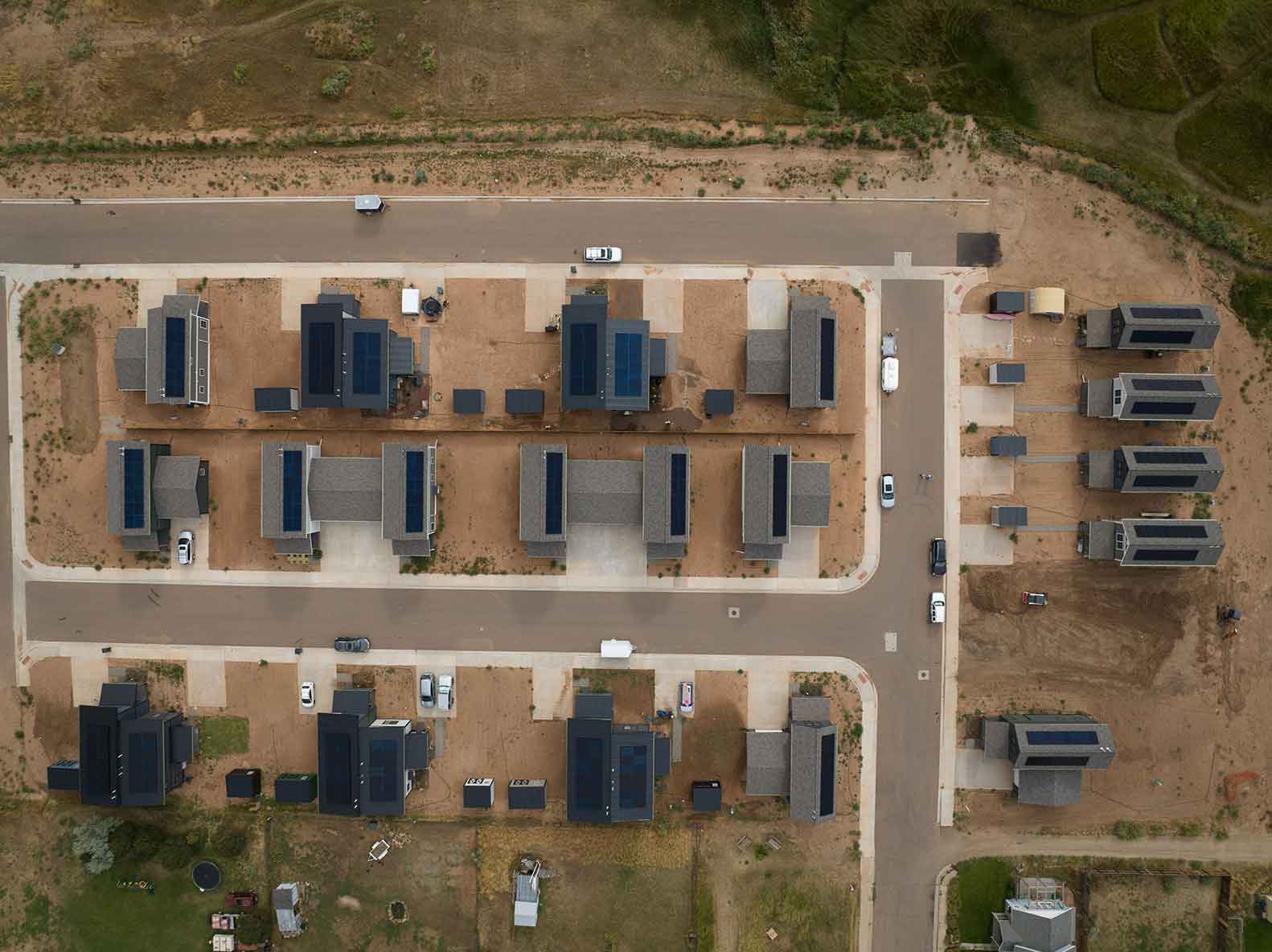
An aerial view of Rural Homes’ Pinion Park development in Norwood. Photo by Corey Robinson / Special to The Colorado Trust
Jennie Thomas, a social worker in the Norwood School District, moved from a home she was renting in Norwood into one of the Pinion Park houses last May, leaving behind a monthly rent of $1,800. Her new mortgage payment is $1,510.
Thomas is disappointed that she has so few neighbors. If there was no demand for the houses, she wonders, did she pay too much? If so many houses remain vacant, why was a lottery even necessary?
“If you’re a builder and you build houses and you don’t sell them, eventually you sell them at a lower price, right?” says Thomas. “You can’t hold on to them indefinitely. That will shoot my home’s value in the foot, right?”
Thomas bought a three-bedroom house, though the third “bedroom” does not include a closet. If her house is reclassified as two bedrooms to expand the pool of potential buyers, she worries that the change will again reduce the value of what she purchased.
Thomas also says she has had electrical issues with her appliances and that the interior drywall was cracked and only given a coat of primer—not the final coat of paint. (Major says Rural Homes addressed all of Thomas’ concerns as soon as they were notified of the issues.)
Neighbor John “Sully” Sullivan, who commutes daily to manage the Wine Mine liquor store in Telluride, says his dryer also went out when he first moved in last March. Rural Homes quickly replaced the breaker, he says, and he has found his two-bedroom unit to be well constructed and insulated. Major’s team, says Sullivan, has been “super helpful” anytime he calls.
“It’s a sweet home for the cost that I paid and the interest rate that I got,” he says. That rate on Sullivan’s mortgage is 2.5%. His monthly payments are $989, almost half of his previous $1,800 in rent in Telluride—with roommates.
At one point, Sullivan moved four times in eight months. The last house he was living in as a renter sold for $3 million in cash—for 2,400 square feet that “needs work,” says Sullivan. Cutting his housing costs by nearly half and gaining stability is worth the 40-minute commute. Most days, Sullivan stops to fly fish in the San Miguel River and visit friends.
Sullivan has been working in Telluride for 10 years and says he’s seen the town’s sense of community diminish. Too many residents are only there part-time, he says. By contrast, he adds, Norwood is “vibrant.”
But Thomas wonders if that sense of community is taking root in Pinion Park, with so many empty units, and whether Rural Homes’ initiative is truly meeting Norwood’s needs.
“I’ve heard community complaining about, you know, that the houses [in Pinion Park] are not affordable—these houses range up to like $425,000,” she says. “And Rural Homes argues that is their cost, that is the price without anybody making a profit. Well, if that is the price with nobody making a profit, then our system is so far broken.”
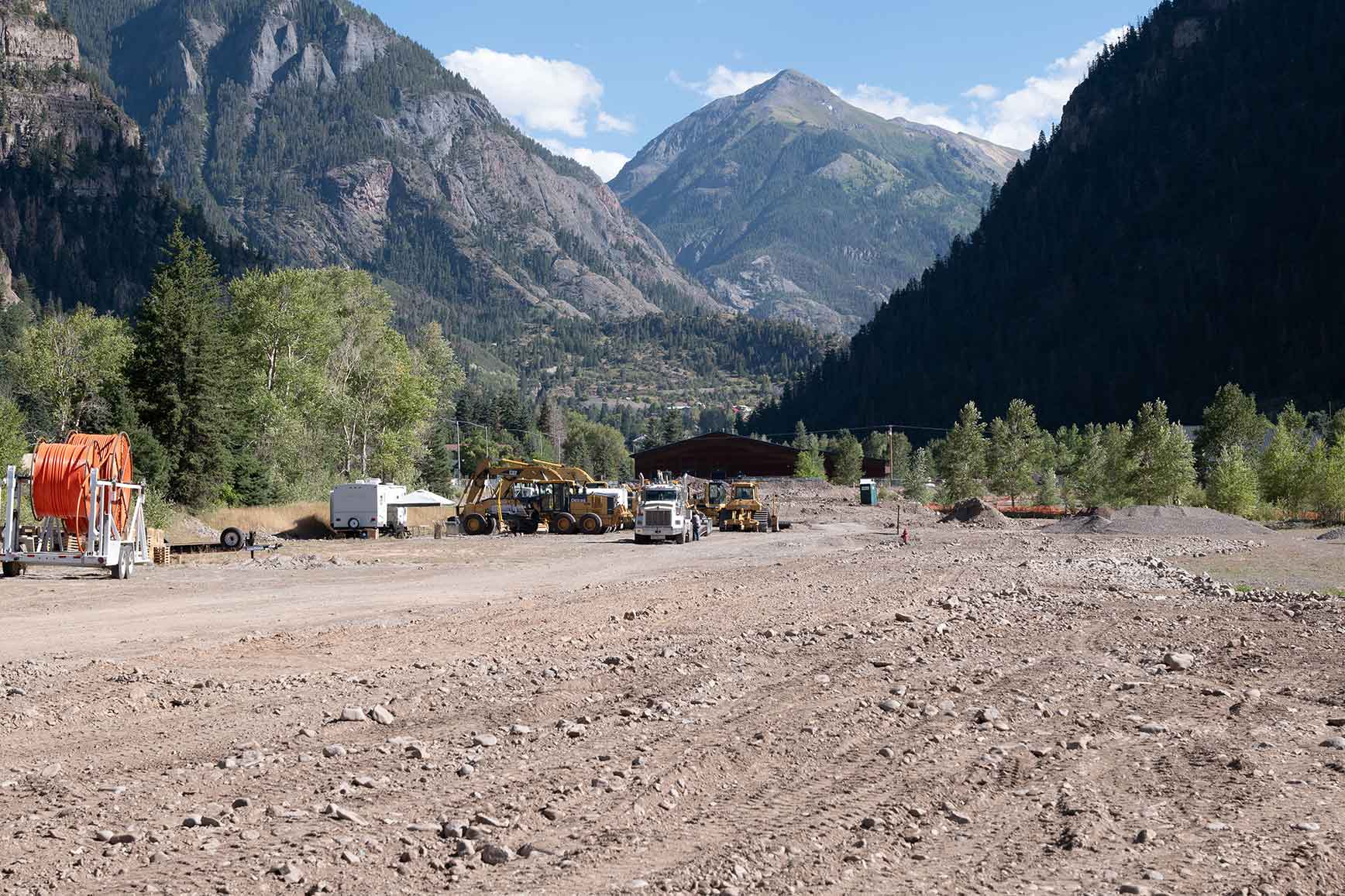
The Rural Homes development in Ouray includes views up the scenic canyon towards town. Photo by Corey Robinson / Special to The Colorado Trust
Asked if he is nervous about Pinion Park not filling up yet, Major says, “I’m nervous about everything.” Rural Homes is doing more grassroots marketing and trying to reach those with sufficient salaries who don’t think homeownership is within reach. A dozen recent potential buyers, says Major, either made too much money or were already carrying too much debt. The four current applicants, however, are all Norwood residents.
Like in Norwood, the Ridgway School District also bought one of the new houses. The new house takes the place of a district-owned house that was “pretty rustic,” says Susan Lacy, the district’s superintendent; tenants only lasted a year there at the longest.
Four Ridgway teachers—three who were renting and one who was commuting 26 miles from Montrose—will take ownership in the Rural Homes development, known as Wetterhorn, in October. The district-owned house will be rented to another educator.
“In 2017, you could buy a 1,800-square-foot home [in Ridgway] for $350,000,” says Lacy. “And then the pandemic hit and now that same home would sell for $800,000. It’s become clear that if we hire a single teacher or someone who doesn’t have a double income, it’s going to be difficult for them to find an affordable place in Ridgway.”
Starting teacher salaries in Ridgway are $41,200, thanks to a recent mill levy hike that raised all salaries by 15%. The median teacher salary is $57,000, says Lacy.
The Rural Homes effort in Ridgway is a “huge win,” she says.
Ten miles southeast, in Ouray, work this fall is devoted to site preparation. The construction schedule delayed assembly of the houses until spring 2024. The Rural Homes project in Ouray, when complete, will be the largest of the three. Phase 1, with 21 homes, will be completed in the summer of 2024. Phase 2 will bring another 44 homes the following year.
Curtis Broome is the project manager for Built, the Longmont-based company that is overseeing the construction in Ouray. Built is owned by Brandon White, who grew up in Ouray. The Rural Homes project is “heartfelt,” says Broome, because White and the whole team knows the positive impact it will have on the community. Broome is sleeping in his pickup truck this fall while he and his wife renovate a house in Ouray.
“It’s nice to be able to come out for a project and say, ‘this is fundamentally great,’” says Broome. “Hopefully there’s enough transparency, enough good lessons learned that Paul can take this and scale it up to what really needs to happen.”

